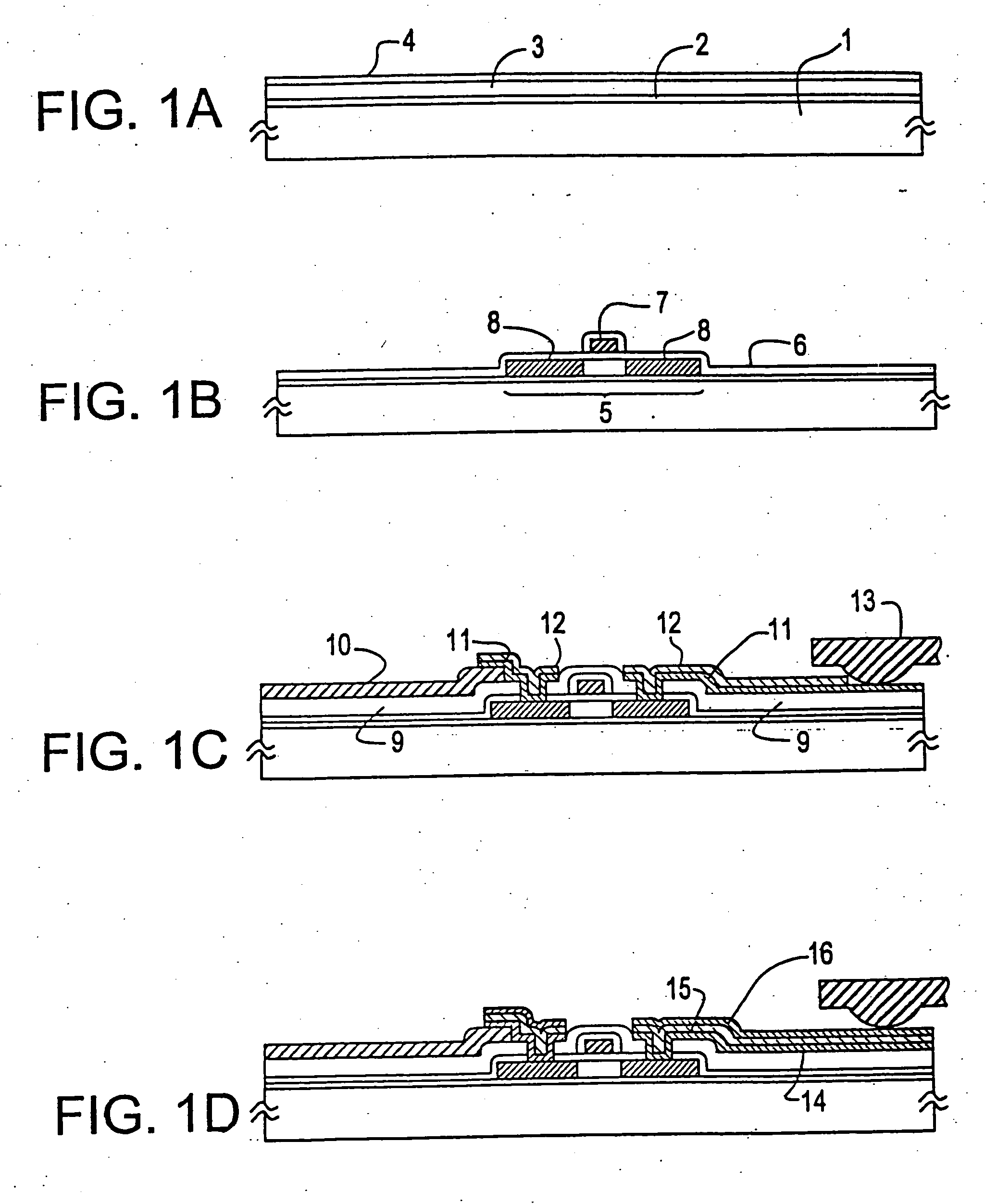Electronic circuit
- Summary
- Abstract
- Description
- Claims
- Application Information
AI Technical Summary
Benefits of technology
Problems solved by technology
Method used
Image
Examples
example 1
[0029] Example 1 is shown in FIGS. 1, (A)-(D), and 2, (A)-(B). FIGS. 1, (A)-(D), illustrate the sequence in which an electronic circuit having TFTs is fabricated. Description of conventional steps is omitted. First, silicon oxide was deposited as a silicon oxide film 2 forming a base film on a glass substrate 1 made of Corning 7059. An amorphous silicon film 3 having a thickness of 500 to 1500 Å, preferably 500 to 750 Å, was formed on the silicon oxide film 2. A protective layer 4 was formed on the amorphous silicon film 3. The laminate was annealed at 450 to 600° C. for 12 to 48 hours to crystallize the amorphous silicon film. Of course, laser annealing or other similar means can be used for the crystallization (FIG. 1(A)).
[0030] The silicon film was photolithographically patterned into island-shaped semiconductor regions 5. A silicon oxide film 6 having a thickness of 500 to 1500 Å, preferably 800 to 1000 Å, was formed on the semiconductor regions 5 to form a gate oxide film. The...
example 2
[0042] The present example is described by referring to FIG. 1, (A)-(D), which conceptually illustrate the sequence in which an electronic circuit having TFTs is fabricated. Conventional steps are not described herein. First, silicon oxide was deposited as a silicon oxide base film 2 on a glass substrate 1. An amorphous silicon film 3 having a thickness of 100 to 1500 Å, preferably 100 to 750 Å, was formed on the silicon oxide film 2. A protective layer 4 was formed on the amorphous silicon film 3. The laminate was annealed at 450 to 600° C. for 12 to 48 hours to crystallize the amorphous silicon film. Of course, laser annealing or other similar means can also be used for the crystallization (FIG. 1(A)).
[0043] The silicon film was photolithographically patterned into island-shaped semiconductor regions 5. A silicon oxide film 6 having a thickness of 500 to 1500 Å, preferably 800 to 1000 Å, was formed on the semiconductor regions 5 to form a gate oxide film. Then, gate interconnects...
example 3
[0048] The present example is shown in FIGS. 7, (A)-(H). First, silicon oxide was deposited as a silicon oxide film 202 on a glass substrate 201 made of Corning 7059. The silicon oxide film formed a base film and had a thickness of 1000 to 3000 Å. The substrate measured 300 mm×400 mm or 100 mm×100 mm. To form this oxide film, sputtering was effected within oxygen ambient. To make mass production more efficient, TEOS may be decomposed and deposited by plasma CVD.
[0049] Then, amorphous silicon was deposited as a film having a thickness of 300 to 5000 Å, preferably 500 to 1000 Å, by plasma CVD or LPCVD. This film was allowed to stand within an oxidizing ambient at 550 to 600° C. for 24 hours to crystallize the film. This step may also be carried out by laser irradiation. The crystallized silicon film was photolithographically patterned into island-shaped regions 203. A silicon oxide film 104 having a thickness of 700 to 1500 Å was formed by sputtering techniques.
[0050] An aluminum fi...
PUM
| Property | Measurement | Unit |
|---|---|---|
| Current | aaaaa | aaaaa |
| Semiconductor properties | aaaaa | aaaaa |
| Electrical resistivity | aaaaa | aaaaa |
Abstract
Description
Claims
Application Information
 Login to View More
Login to View More - R&D
- Intellectual Property
- Life Sciences
- Materials
- Tech Scout
- Unparalleled Data Quality
- Higher Quality Content
- 60% Fewer Hallucinations
Browse by: Latest US Patents, China's latest patents, Technical Efficacy Thesaurus, Application Domain, Technology Topic, Popular Technical Reports.
© 2025 PatSnap. All rights reserved.Legal|Privacy policy|Modern Slavery Act Transparency Statement|Sitemap|About US| Contact US: help@patsnap.com



